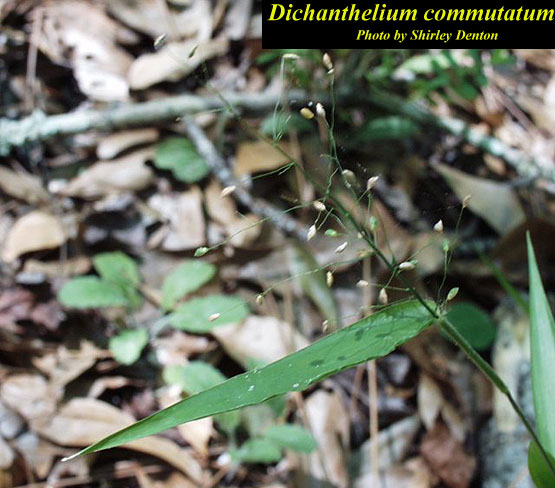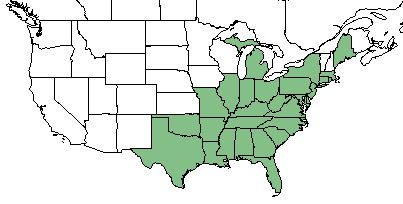Difference between revisions of "Dichanthelium commutatum"
(→Ecology) |
|||
| Line 34: | Line 34: | ||
Common habitats for ''D. commutatum'' include low, shaded, moist woodlands and edges of woodlands, as well as dry, thin, and rocky woods and thickets. <ref name= "Weakley"> Weakley, A. S. (2015). Flora of the Southern and Mid-Atlantic States. Chapel Hill, NC, University of North Carolina Herbarium.</ref> | Common habitats for ''D. commutatum'' include low, shaded, moist woodlands and edges of woodlands, as well as dry, thin, and rocky woods and thickets. <ref name= "Weakley"> Weakley, A. S. (2015). Flora of the Southern and Mid-Atlantic States. Chapel Hill, NC, University of North Carolina Herbarium.</ref> | ||
| + | ''D. commutatum'' has a medium tolerance for drought and shade. <ref name= "USDA"> [https://plants.usda.gov/core/profile?symbol=CEAM USDA Plant Database]</ref> | ||
| − | + | Specimens of panicgrass have been collected in habitats that include drying loamy sand, near limestone wooded area, hardwood hammocks, longleaf pine woodland, dry sandy soil, flat oak woods, margin of field, dry banks, slash pine savanna, edge of wooded floodplain, swamp clearing, oak hammock, oak woodland, mixed hardwood forests, shaded hardwood, and swamp forests. <ref name = "FSU herbarium"> URL: http://herbarium.bio.fsu.edu. Last accessed: June 2018. Collectors: Loran C. Anderson, Wilson Baker, Cecil R. Slaughter, H. Blomquist, Robert A. Norris, James P. Gillespie, H. R. Reed, R. Kral, R. Wilbur, Harry Ahles, A. Hammond, Delzie Demaree, H. Sherman, G. Carter, John W. Thierst, S. Blake, Frank Bowers, Gary Morton, Paul Hallister, Ken Rogers, r. K. Godfrey, Stanley Cain, Duane Isely, S Walsh, Dwight Isely, Sidneu McDaniel, C. Clark, W. Silveus, W. Ashe, S. Leonard, A. Radford, Randy Haynes, C. Jackson, R. L. Lazor, A. . Clewell, James . Ray Jr.., H. Kurz, Ira Wiggins, D. B. Ward, D. Burch, George Cooley, Gwynn Ramsey, R. S. Mitchell, Richard Eaton, Patricia Elliot, D.L. Martin, S. Cooper, D. Hall, Bob Simmons, Buford Pruitt, R.L. Wilbur, G. Webster, A. Curtiss, R.E. Perdue, Sid McDaniel, Bruce Hansen, JoAnn Hansen, A. G. Shuey, Gil Nelson, Marc Mino, J. M. Kane, Lisa Keppner, L. Peed, F. Sargent, R.E. Perdue, J.B. McFarlin, O. Lakela. States and counties: Florida ( Taylor, Jefferson, Jackson, Indian River, Wakulla, Thomas, Gadsden, Leon, Franklin, Walton, Madison, Volusia, Calhoun, Okaloosa, Clay, Levy, Lafayette, Escambia, Monroe, Flagler, Hernando, Suwannee, Citrus, Liberty, Bay, Marion, Nassau, Highlands, Duval, Alachua, St. John, DeSoto, Polk, Brevard, Washington, Dixie, Holmes), North Carolina (Brunswick, granville, Cumberland, Dare), Georgia (Lee, Thomas, Grady), Alabama (Geneva), Mississippi (Hancock), Louisiana (DCaldwell, Ouachita, Umiom, St. Landry, St. Mary), Virginia (Montgomery, Dickenson, Arlington, Roanoke), Arkansas (Cleburne, Stone), Alabama (De Kalb, Houston), Massachusetts, Tennessee (Bradley, Putnam, Franklin), Kentucky (Carlisle), Texas (Burleson), South Carolina (Chester), Missouir (McDonald) </ref> | |
| − | |||
This species does not require a moist environment but it can grow in wetter condition. <ref name= "USDA"> [https://plants.usda.gov/core/profile?symbol=CEAM USDA Plant Database]</ref> | This species does not require a moist environment but it can grow in wetter condition. <ref name= "USDA"> [https://plants.usda.gov/core/profile?symbol=CEAM USDA Plant Database]</ref> | ||
Revision as of 13:39, 14 June 2018
Common Names: Variable Panicgrass [1], Variable Witchgrass [2]
| Dichanthelium commutatum | |
|---|---|

| |
| Photo by the Atlas of Florida Plants Database | |
| Scientific classification | |
| Kingdom: | Plantae |
| Division: | Magnoliophyta - Flowering plants |
| Class: | Liliopsida - Moncots |
| Order: | Cyperales |
| Family: | Poaceae |
| Genus: | Dichanthelium |
| Species: | D. communtatum |
| Binomial name | |
| Dichanthelium commutatum Schult. | |

| |
| Natural range of Dichanthelium commutatum from USDA NRCS Plants Database. | |
Contents
Taxonomic Notes
Synonym: none
Variety: D. commutatum var. ashei (J.A. Shultes) Gould
Description
D. communtatum is a perennial gramioid of the Poaceae family that is native to North America. [1]
Distribution
D. commutatum is found throughout the eastern United States, reaching as far west as Texas and as far north as Maine and Michigan. [1]
Ecology
Habitat
Common habitats for D. commutatum include low, shaded, moist woodlands and edges of woodlands, as well as dry, thin, and rocky woods and thickets. [3]
D. commutatum has a medium tolerance for drought and shade. [1]
Specimens of panicgrass have been collected in habitats that include drying loamy sand, near limestone wooded area, hardwood hammocks, longleaf pine woodland, dry sandy soil, flat oak woods, margin of field, dry banks, slash pine savanna, edge of wooded floodplain, swamp clearing, oak hammock, oak woodland, mixed hardwood forests, shaded hardwood, and swamp forests. [4]
This species does not require a moist environment but it can grow in wetter condition. [1]
Phenology
D. commutatum will typically bloom during spring, with April producing the majority of blooms. [5]
Fire ecology
D. commutatum has no tolerance for fire. [1]
Use by animals
This grass can be a supplementary food source for many terrestrial birds. [1]
Conservation and Management
D. commutatum is considered endangered in the state of Illinois. [1]
Cultivation and restoration
Photo Gallery
References and notes
- ↑ 1.0 1.1 1.2 1.3 1.4 1.5 1.6 1.7 USDA Plant Database
- ↑ Glitzenstein, J. S., et al. (2012). "Fire-frequency effects on vegetation in north Florida pinelands: Another look at the long-term Stoddard Fire Research Plots at Tall Timbers Research Station." Forest Ecology and Management 264: 197-209.
- ↑ Weakley, A. S. (2015). Flora of the Southern and Mid-Atlantic States. Chapel Hill, NC, University of North Carolina Herbarium.
- ↑ URL: http://herbarium.bio.fsu.edu. Last accessed: June 2018. Collectors: Loran C. Anderson, Wilson Baker, Cecil R. Slaughter, H. Blomquist, Robert A. Norris, James P. Gillespie, H. R. Reed, R. Kral, R. Wilbur, Harry Ahles, A. Hammond, Delzie Demaree, H. Sherman, G. Carter, John W. Thierst, S. Blake, Frank Bowers, Gary Morton, Paul Hallister, Ken Rogers, r. K. Godfrey, Stanley Cain, Duane Isely, S Walsh, Dwight Isely, Sidneu McDaniel, C. Clark, W. Silveus, W. Ashe, S. Leonard, A. Radford, Randy Haynes, C. Jackson, R. L. Lazor, A. . Clewell, James . Ray Jr.., H. Kurz, Ira Wiggins, D. B. Ward, D. Burch, George Cooley, Gwynn Ramsey, R. S. Mitchell, Richard Eaton, Patricia Elliot, D.L. Martin, S. Cooper, D. Hall, Bob Simmons, Buford Pruitt, R.L. Wilbur, G. Webster, A. Curtiss, R.E. Perdue, Sid McDaniel, Bruce Hansen, JoAnn Hansen, A. G. Shuey, Gil Nelson, Marc Mino, J. M. Kane, Lisa Keppner, L. Peed, F. Sargent, R.E. Perdue, J.B. McFarlin, O. Lakela. States and counties: Florida ( Taylor, Jefferson, Jackson, Indian River, Wakulla, Thomas, Gadsden, Leon, Franklin, Walton, Madison, Volusia, Calhoun, Okaloosa, Clay, Levy, Lafayette, Escambia, Monroe, Flagler, Hernando, Suwannee, Citrus, Liberty, Bay, Marion, Nassau, Highlands, Duval, Alachua, St. John, DeSoto, Polk, Brevard, Washington, Dixie, Holmes), North Carolina (Brunswick, granville, Cumberland, Dare), Georgia (Lee, Thomas, Grady), Alabama (Geneva), Mississippi (Hancock), Louisiana (DCaldwell, Ouachita, Umiom, St. Landry, St. Mary), Virginia (Montgomery, Dickenson, Arlington, Roanoke), Arkansas (Cleburne, Stone), Alabama (De Kalb, Houston), Massachusetts, Tennessee (Bradley, Putnam, Franklin), Kentucky (Carlisle), Texas (Burleson), South Carolina (Chester), Missouir (McDonald)
- ↑ Pan Flora